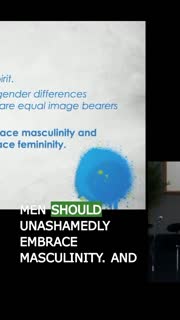Understanding Biblical Context: Gender Roles and Modesty
Summary
### Summary
In today's sermon, we explored the complexities of interpreting biblical texts, particularly focusing on 1 Corinthians 11 and the issue of head coverings. The sermon began with an analogy about breathing, emphasizing that while some things in life are intuitive, others require focused effort and understanding, much like interpreting certain biblical texts. The key principle highlighted was that the Bible was written for us but not to us, meaning we must first understand the original context and audience before applying its teachings to our lives.
We delved into the cultural and historical background of the Corinthian church to understand why Paul addressed the issue of head coverings. In first-century Corinth, head coverings for women symbolized modesty, chastity, and fidelity in marriage. The new Roman woman of that era, who rejected these symbols, was causing contention within the church. Paul’s instructions were aimed at maintaining order and respect for God-given roles within the church community.
The sermon emphasized that men and women are equal in dignity and worth but have different, complementary roles. This is rooted in the created order, as seen in Genesis, where Eve was created as a helper for Adam, not as an inferior but as an equal with a distinct role. The head covering was a cultural symbol of this order and respect for marital roles.
In applying these teachings to our context, the sermon stressed the importance of avoiding a contentious spirit, celebrating gender differences, and embracing our God-given roles. While the specific cultural practice of wearing head coverings may not apply today, the underlying principles of modesty, respect, and submission to God’s design remain relevant.
### Key Takeaways
1. Understanding Context is Crucial: The Bible was written for us but not to us. This means we must first understand the original audience and context to accurately interpret and apply its teachings. This principle is foundational for proper biblical interpretation and helps prevent misapplication of Scripture. [10:06]
2. Equality and Complementarity: Men and women are equal in dignity and worth but have different, complementary roles. This is rooted in the created order, as seen in Genesis. Eve was created as a helper for Adam, not as an inferior but as an equal with a distinct role. This understanding helps us appreciate the unique contributions of both genders in fulfilling God’s purposes. [15:09]
3. Avoiding a Contentious Spirit: The issue of head coverings in Corinth was causing contention within the church. Paul’s instructions were aimed at maintaining order and respect for God-given roles. We must avoid a spirit of radical individualism that prioritizes self-expression over the edification of the church community. [41:18]
4. Celebrating Gender Differences: We should not be ashamed of gender differences but celebrate them as part of God’s design. Men and women bring unique perspectives and strengths that are essential for the health and growth of the church. This is especially important in a culture that often seeks to blur or erase these differences. [42:52]
5. Modesty and Appropriateness: While the specific cultural practice of wearing head coverings may not apply today, the principles of modesty, respect, and appropriateness in our dress and behavior remain relevant. Our outward appearance should reflect our gender and be suitable for the occasion, particularly in worship settings. [47:00]
### YouTube Chapters
[0:00] - Welcome
[03:58] - Personal Story: Firefighter Training
[06:13] - Introduction to the Text
[09:29] - Prayer and Opening Remarks
[10:06] - Key Interpretive Principle
[12:33] - Clues in the Text
[14:09] - Equality and Complementarity
[16:02] - Created Order and Cultural Context
[20:54] - Role of Helper in Genesis
[24:00] - Headship and Authority
[25:28] - Summary of the Issue
[27:22] - Cultural Significance of Head Coverings
[29:22] - The New Roman Woman
[32:18] - Men and Head Coverings
[33:59] - Women and Head Coverings
[35:42] - The Role of Angels
[40:24] - Application: Avoiding Contentious Spirit
[42:12] - Application: Celebrating Gender Differences
[43:49] - Application: Embracing Masculinity and Femininity
[47:00] - Conclusion: Modesty and Appropriateness
Study Guide
### Bible Reading
1. 1 Corinthians 11:2-16
2. Genesis 2:18-24
3. 1 Timothy 2:9-10
### Observation Questions
1. What cultural significance did head coverings have for women in first-century Corinth? [27:22]
2. According to the sermon, what was the primary reason Paul addressed the issue of head coverings in the Corinthian church? [13:14]
3. How does Paul use the created order in Genesis to support his argument about head coverings? [16:02]
4. What does the sermon suggest about the role of men and women in the church, based on 1 Corinthians 11? [15:09]
### Interpretation Questions
1. Why is it important to understand the original audience and context when interpreting biblical texts? How does this principle help prevent misapplication of Scripture? [10:06]
2. How does the concept of equality and complementarity between men and women, as discussed in the sermon, influence our understanding of gender roles in the church today? [15:09]
3. What does it mean to avoid a contentious spirit in the context of church practices and traditions? How can this principle be applied in modern church settings? [41:18]
4. How can celebrating gender differences contribute to the health and growth of the church, according to the sermon? [42:52]
### Application Questions
1. Reflect on a time when you misinterpreted a Bible passage because you didn't consider the original context. How did this affect your understanding and application of the passage? What steps can you take to improve your biblical interpretation skills? [10:06]
2. In what ways can you celebrate and embrace the unique contributions of both genders in your church community? How can you encourage others to do the same? [42:52]
3. Think about a situation in your church where there was contention over a practice or tradition. How was it resolved? What can you learn from that experience to avoid a contentious spirit in the future? [41:18]
4. How do you currently express modesty, respect, and appropriateness in your dress and behavior, especially in worship settings? Are there any changes you feel led to make based on the sermon? [47:00]
5. Identify one way you can support and affirm the God-given roles of men and women in your family or church. How can you practically demonstrate this support in your daily interactions? [24:00]
6. How can you balance the need for self-expression with the importance of edifying the church community? Share a specific example where you might need to prioritize the church's edification over personal preferences. [41:18]
7. Consider the cultural practices in your community that might conflict with biblical principles. How can you navigate these practices while staying true to your faith and respecting others? [46:13]
Devotional
Day 1: Understanding Context is Crucial
The Bible was written for us but not to us. This means we must first understand the original audience and context to accurately interpret and apply its teachings. This principle is foundational for proper biblical interpretation and helps prevent misapplication of Scripture. By delving into the cultural and historical background of the Corinthian church, we can better understand why Paul addressed the issue of head coverings. In first-century Corinth, head coverings for women symbolized modesty, chastity, and fidelity in marriage. The new Roman woman of that era, who rejected these symbols, was causing contention within the church. Paul’s instructions were aimed at maintaining order and respect for God-given roles within the church community. [10:06]
1 Corinthians 11:4-5 (ESV): "Every man who prays or prophesies with his head covered dishonors his head, but every wife who prays or prophesies with her head uncovered dishonors her head, since it is the same as if her head were shaven."
Reflection: Think of a biblical passage that you find challenging to understand. How can you research its historical and cultural context to gain a clearer understanding of its meaning?
Day 2: Equality and Complementarity
Men and women are equal in dignity and worth but have different, complementary roles. This is rooted in the created order, as seen in Genesis. Eve was created as a helper for Adam, not as an inferior but as an equal with a distinct role. This understanding helps us appreciate the unique contributions of both genders in fulfilling God’s purposes. By recognizing and valuing these differences, we can better serve within our church and community, reflecting God’s design for harmony and cooperation. [15:09]
Genesis 2:18 (ESV): "Then the Lord God said, 'It is not good that the man should be alone; I will make him a helper fit for him.'"
Reflection: Reflect on a time when you worked alongside someone of the opposite gender in a ministry or service project. How did their unique strengths complement your own, and how did this partnership enhance the overall outcome?
Day 3: Avoiding a Contentious Spirit
The issue of head coverings in Corinth was causing contention within the church. Paul’s instructions were aimed at maintaining order and respect for God-given roles. We must avoid a spirit of radical individualism that prioritizes self-expression over the edification of the church community. Instead, we should strive for unity and peace, valuing the well-being of the entire congregation over personal preferences. This approach fosters a healthy church environment where everyone can grow and thrive. [41:18]
Philippians 2:3-4 (ESV): "Do nothing from selfish ambition or conceit, but in humility count others more significant than yourselves. Let each of you look not only to his own interests, but also to the interests of others."
Reflection: Consider a recent disagreement or conflict within your church or community. How can you approach the situation with humility and a focus on unity, rather than insisting on your own way?
Day 4: Celebrating Gender Differences
We should not be ashamed of gender differences but celebrate them as part of God’s design. Men and women bring unique perspectives and strengths that are essential for the health and growth of the church. This is especially important in a culture that often seeks to blur or erase these differences. By embracing and valuing our God-given roles, we can better reflect His image and fulfill His purposes in our lives and communities. [42:52]
1 Peter 3:7 (ESV): "Likewise, husbands, live with your wives in an understanding way, showing honor to the woman as the weaker vessel, since they are heirs with you of the grace of life, so that your prayers may not be hindered."
Reflection: Think about the unique qualities and strengths of the men and women in your life. How can you encourage and support them in using these gifts for the benefit of the church and the glory of God?
Day 5: Modesty and Appropriateness
While the specific cultural practice of wearing head coverings may not apply today, the principles of modesty, respect, and appropriateness in our dress and behavior remain relevant. Our outward appearance should reflect our gender and be suitable for the occasion, particularly in worship settings. By dressing modestly and appropriately, we show respect for ourselves, others, and God, creating an environment conducive to worship and community. [47:00]
1 Timothy 2:9-10 (ESV): "Likewise also that women should adorn themselves in respectable apparel, with modesty and self-control, not with braided hair and gold or pearls or costly attire, but with what is proper for women who profess godliness—with good works."
Reflection: Evaluate your current wardrobe and consider how your clothing choices reflect your values and respect for God. Are there any changes you can make to better align with the principles of modesty and appropriateness?
Quotes
### Quotes for Outreach
1. "You know, there are some things in life that are very intuitive and require no, little or no instruction. Like breathing. No one taught you that it sat down and gave you a lesson, you know, when you're a kid, okay, this is how you breathe. We instinctively just do it, right? However, there are times where we have to do focus on our breathing because of unusual circumstances." [03:58] (29 seconds)
2. "The Bible was written for us but it was not written to us. Okay. You have to understand that. If we're going to properly interpret the scriptures. And if I die and you don't understand this principle. My ministry is a failure." [10:06] (16 seconds)
3. "Men and women need each other. So women then are not inferior to men. Rather, they're equal in dignity and in worth. That's what he's saying here in verse 11 and 12. He's saying, Nevertheless, in the Lord, woman is not independent of man nor man of the woman here." [14:09] (20 seconds)
4. "We should not be ashamed of gender differences knowing that men and women are equal image bearers of God. Okay. We should not be ashamed of this. That men and women are different. Okay. That they are equal image bearers but they're different with different giftedness and different wiring. And that is by God's design. We shouldn't be ashamed of that. We shouldn't try to put that down. We shouldn't try to neutralize all of that. In fact, it should be celebrated." [42:52] (33 seconds)
5. "Men should unashamedly embrace masculinity. And women should cheerfully embrace masculinity. Okay? Clearly, in this text, he's using the idea of even length of hair. And we didn't get into all that. We just didn't have time to get into all that. But he's using length of hair. He's using different things to show that there are obvious signs, outward signs, that a man is a man and a woman is a woman. We should embrace that. Rather than try to be ashamed of it. Or erase those things." [43:49] (36 seconds)
### Quotes for Members
1. "So the Bible was written for us. So it's for instruction. We saw that a couple sermons ago. When Paul talks about this. He's like this in chapter 10. Beginning of chapter 10 with Moses. He says this was written for our instruction. So it's written for us. But the Bible wasn't written to us. What I mean by that is that when Paul picked up the pen here. Paul's the author of this. He did not have Verona, Wisconsin 2024 in mind when he wrote. Okay. He had the church of Corinth in mind. In the first century. That's who he had in mind." [10:41] (32 seconds)
2. "So the woman was made from man is the foundation of her equality with man. Adam, when he saw Eve, he did not see someone inferior. He saw someone different. He saw someone that had divinely given strengths and roles. But he did not see someone who was inferior. Looking at Genesis 2. It reveals that Eve was created with the express purpose of being Adam's helper." [18:30] (28 seconds)
3. "So what we can see then is it is clear from Adam's response that he sees Eve as her equal. Adam does not see Eve as an animal to dominate. Instead, Adam rightly sees Eve as someone of his own accord. A woman of his own flesh. Unlike any of the other potential helpers considered before Eve's creation." [18:30] (22 seconds)
4. "So what we do though, what we do though is we do preach that all of us should dress in a way that reflects our gender. Because we see that in the text. And is modest and appropriate for the occasion. Okay? For the occasion. This is all about when praying and prophesying in a church gathering. So, our dress should reflect our gender, according to this text, and be modest and appropriate for the occasion." [47:00] (26 seconds)
5. "So, what we're not saying here. We're not saying that the only purpose women have is to bear children. That's not what we're saying. But what we are saying. Is that a fundamental mandate given to Adam. Was to be fruitful and multiply. And he couldn't do it himself. He couldn't do it with animals. He needed a woman. And so. That is the job that was given to them to work together here." [23:07] (24 seconds)










